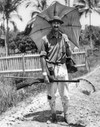|
The Palaeontology Portal
Introduction Paleontology (/ˌpeɪliɒnˈtɒlədʒi, ˌpæli-, -ən-/ PAY-lee-on-TOL-ə-jee, PAL-ee-, -ən-), also spelled palaeontology or palæontology, is the scientific study of life that existed prior to the start of the Holocene epoch (roughly 11,700 years before present). It includes the study of fossils to classify organisms and study their interactions with each other and their environments (their paleoecology). Paleontological observations have been documented as far back as the 5th century BC. The science became established in the 18th century as a result of Georges Cuvier's work on comparative anatomy, and developed rapidly in the 19th century. The term has been used since 1822 formed from Greek παλαιός ('palaios', "old, ancient"), ὄν ('on', (gen. 'ontos'), "being, creature"), and λόγος ('logos', "speech, thought, study"). Paleontology lies on the border between biology and geology, but it differs from archaeology in that it excludes the study of anatomically modern humans. It now uses techniques drawn from a wide range of sciences, including biochemistry, mathematics, and engineering. Use of all these techniques has enabled paleontologists to discover much of the evolutionary history of life, almost back to when Earth became capable of supporting life, nearly 4 billion years ago. As knowledge has increased, paleontology has developed specialised sub-divisions, some of which focus on different types of fossil organisms while others study ecology and environmental history, such as ancient climates. (Full article...) Selected article on the prehistoric world and its legacies The Ediacaran biota were ancient lifeforms representing the earliest known complex multicellular organisms. They appeared soon after the Earth thawed from the Cryogenian period's extensive glaciers, and largely disappeared soon before the rapid appearance of biodiversity known as the Cambrian explosion, which saw the first appearance in the fossil record of the basic patterns and body-plans that would go on to form the basis of modern animals. Little of the diversity of the Ediacaran biota would be incorporated in this new scheme, with a distinct Cambrian biota arising and usurping the organisms that dominated the Ediacaran fossil record. Some Ediacaran organisms might have been closely related to groups that would rise to prominence later, but most non-microscopic fossils are morphologically distinct from later lifeforms, resembling discs, mud-filled bags, or quilted mattresses. Classification is difficult, and the assignment of some species even at the level of kingdom — animal, fungus, protist or otherwise — is uncertain: one paleontologist has even gained support for a separate kingdom Vendobionta. Their strange form and apparent disconnectedness from later organisms have led some to consider them a "failed experiment" in multicellular life, with later multicellular life independently re-evolving from unrelated single-celled organisms. (more...) Did you know?

General images -The following are images from various paleontology-related articles on Wikipedia.
Selected article on paleontology in human science, culture and economics
William Beebe was an American naturalist, ornithologist, marine biologist, entomologist, explorer, and author. He is remembered for the numerous expeditions he conducted for the New York Zoological Society, his deep dives in the Bathysphere, and his prolific scientific writing for both academic and popular audiences.
Born in Brooklyn, New York Beebe left college before obtaining a degree in order to work at the then newly opened New York Zoological Park, where he was given the duty of caring for the zoo's birds. Beebe participated in a series of research expeditions, including one intended to document the world's pheasants. He published an account of his pheasant expedition titled A Monograph of the Pheasants. During the course of his expeditions Beebe gradually developed an interest in marine biology, ultimately leading to his 1930s dives in the Bathysphere off the coast of Bermuda. These dives represented the first time a biologist observed deep-sea animals in their native environment. Later, Beebe returned to the tropics and founded a tropical research station which remains in operation as part of the Asa Wright Nature Centre. Beebe's research there continued until his death in 1962. He is also remembered for several theories he proposed about avian evolution which are now regarded as having been ahead of their time, particularly his 1915 hypothesis that the evolution of bird flight passed through a four-winged or "Tetrapteryx" stage, which has been supported by the 2003 discovery of Microraptor gui. (see more...) On this day...June 1:
Selected image
CategoriesTopicsGeneral - Paleontology - Fossil - Evolution - Extinction Quality ContentFeatured paleontology articles
- Achelousaurus
- Acrocanthosaurus
- Albertosaurus
- Allosaurus
- Amargasaurus
- Ankylosaurus
- Apatosaurus
- Archaeopteryx
- Baryonyx
- Carnotaurus
- Catopsbaatar
- Ceratosaurus
- Chicxulub Crater
- Compsognathus
- Cretaceous–Tertiary extinction event
- Daspletosaurus
- Deinocheirus
- Deinonychus
- Deinosuchus
- Dilophosaurus
- Dinosaur
- Diplodocus
- Dromaeosauroides
- Edmontosaurus
- Elasmosaurus
- Giganotosaurus
- Gorgosaurus
- Herrerasaurus
- Iguanodon
- Istiodactylus
- Lambeosaurus
- List of dinosaur genera
- Majungasaurus
- Massospondylus
- Megalodon
- Nemegtomaia
- Nigersaurus
- Opisthocoelicaudia
- Paranthodon
- Parasaurolophus
- Plateosaurus
- Psittacosaurus
- Seorsumuscardinus
- Spinosaurus
- Stegosaurus
- Stegoceras
- Styracosaurus
- Tarbosaurus
- Thescelosaurus
- Triceratops
- Tyrannosaurus
- Velociraptor
Things you can doCurrent Paleontology FACs - None yet... WikiProjectsRelated portalsAssociated WikimediaThe following Wikimedia Foundation sister projects provide more on this subject:
Discover Wikipedia using portals |







































